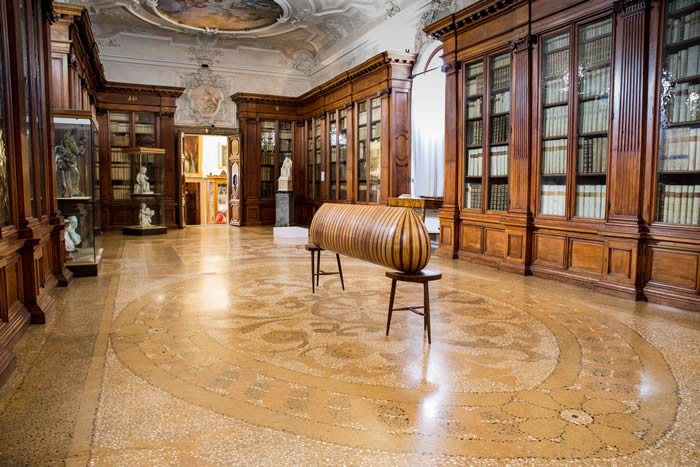Armenity at the Venice Biennial

San Lazzaro degli Armeni is a small island in the Venetian Lagoon. Since 1717 the island has been home to the Armenian Catholic Monastery of San Lazzaro. With its large collection of books, journals, artifacts and the third largest collection of Armenian manuscripts the monastery is one of the best known historic sites of the Armenian diaspora. It is located between San Marco and the Lido and facing the Giardini of the Biennale. It was here that in the early 19th century Lord Byron studied the Armenian language. Many important works of European literature and religious texts were first translated into Armenian on this scenic island.
In 1701 Mechitar Sebastatsi, an Armenian Catholic monk, founded a Catholic order in Constantinople that would later be called after him. The order moved to Methoni in Peloponnese in 1703, after repressions by the Ottoman government. Following its invasion by the Ottoman Empire in April 1715, a group of twelve Armenian Catholic monks led by Mechitar Sebastatsi arrived in Venice. 2 years later the Venetian Senate ceded the island of St. Lazarus to the Mechitarist order. Upon acquisition the construction of a two-storey Armenian monastery began and exists until our days.
In this symbolic year 2015, on the occasion of the one hundredth commemoration of the Armenian Genocide, the Ministry of Culture of the Republic of Armenia has dedicated its pavilion at the 56th International Art Exhibition of la Biennale di Venezia to the artists of the Armenian diaspora. It is located on the island of San Lazzaro degli Armeni.
[widgetkit id=18881]
The curatorial concept of pavillion with the title Armenity implies the notion of displacement and territory, justice and reconciliation, ethos and resilience. Regardless of their place of birth, the selected artists like Hera Büyüktaşcıyan or Silvina Der-Meguerditchian with her exhibition Memory without a Place, carry within their identity the memory of their origins. Through their talent and willpower, these grandchildren of survivors of the Armenian Genocide—the first genocide of the 20th Century—rebuilt a “transnational assembly” from the remnants of a shattered identit y.
Their ingrained concern for memory, justice and reconciliation skillfully transcends notions of territory, borders and geography. Whether they were born in Beirut, Lyon, Los Angeles, or Cairo and wherever they may reside, these global citizens constantly question and reinvent their armenity.
[widgetkit id=18890]
The curator was inspired by the French word Arménité to call the show Armenity. It seemed to her an appropriate new word to describe a new generation of artists and intellectuals in constant flux, which nevertheless kept a subjective sense of being-in-the-world.
The Armenia’s national pavilion at San Lazzaro degli Armeni won the Venice Biennale 2015 Golden Lion award for Best National Participation on May 9 2015.
Curated by Adelina Cüberyan v. Fürstenberg
Participating artists: Haig Aivazian, Lebanon; Nigol Bezjian, Syria/USA; Anna Boghiguian Egypt/Canada; Hera Büyüktaşçıyan, Turkey; Silvina Der-Meguerditchian, Argentina/Germany; Rene Gabri & Ayreen Anastas, Iran/Palestine/USA; Mekhitar Garabedian, Belgium; Aikaterini Gegisian, Greece; Yervant Gianikian & Angela Ricci Lucchi, Italy; Aram Jibilian, USA; Nina Katchadourian, USA/Finland; Melik Ohanian, France; Mikayel Ohanjanyan, Armenia/Italy; Rosana Palazyan, Brasil; Sarkis, Turkey/France; Hrair Sarkissian, Syria/UK.

